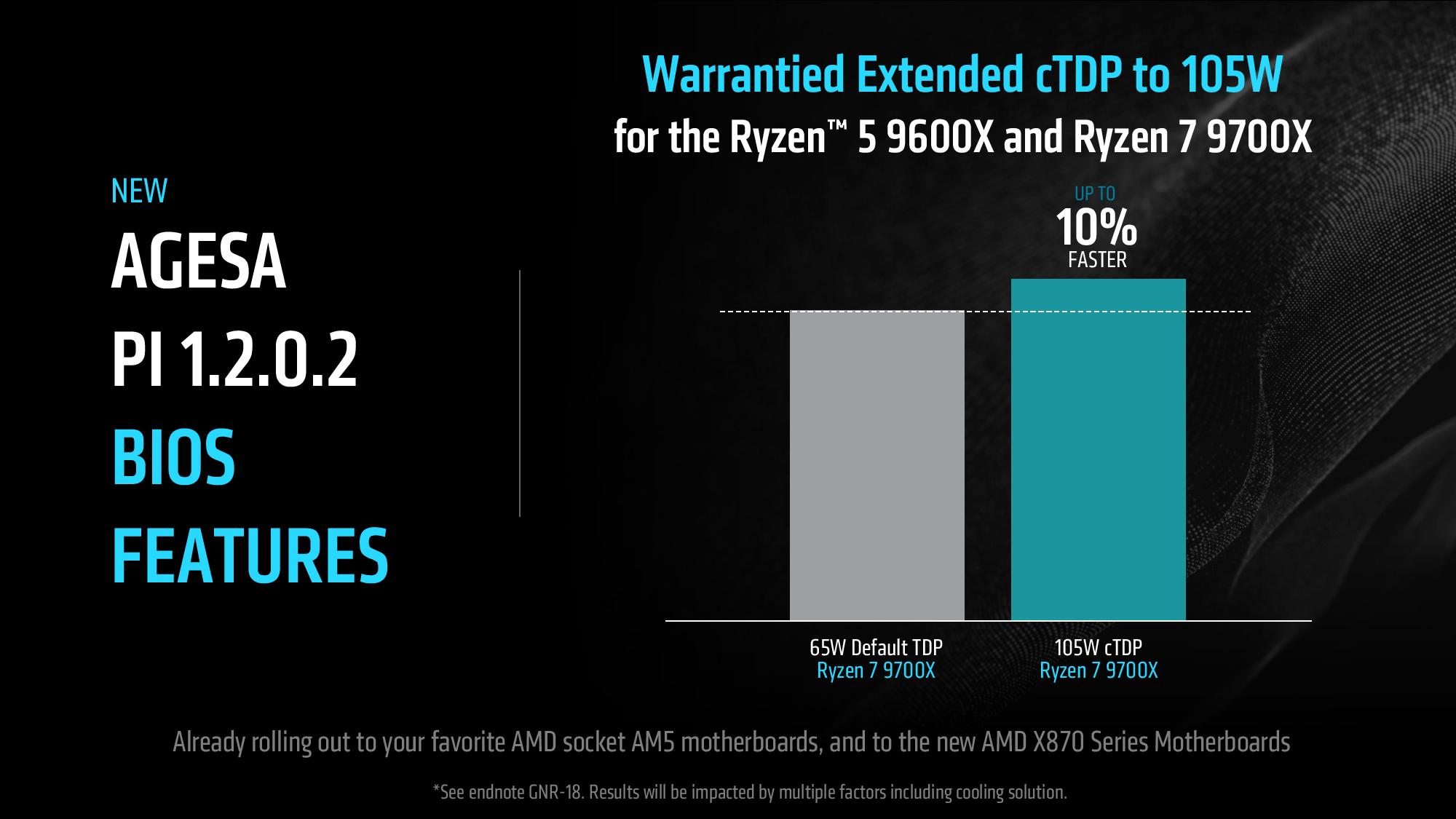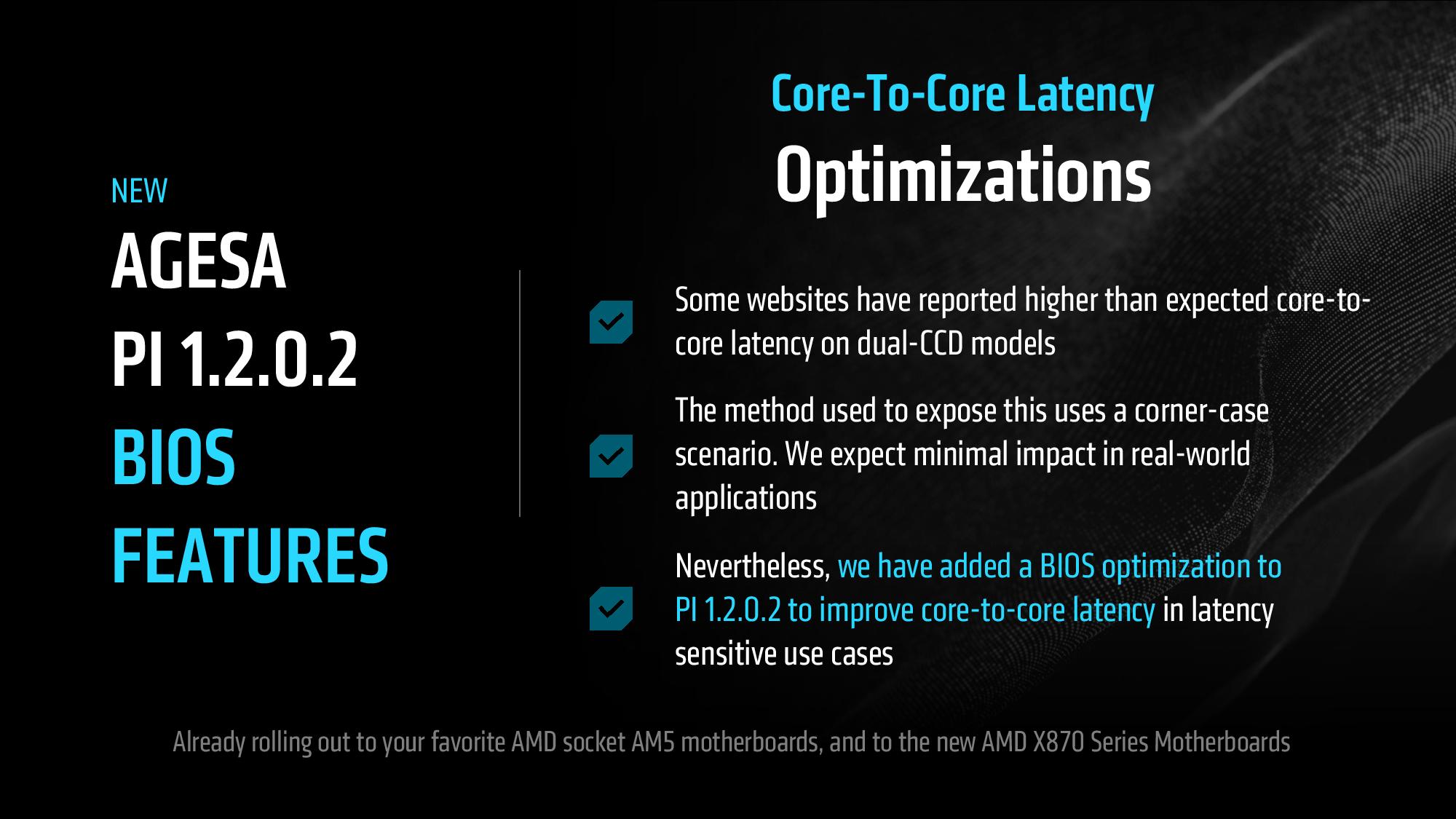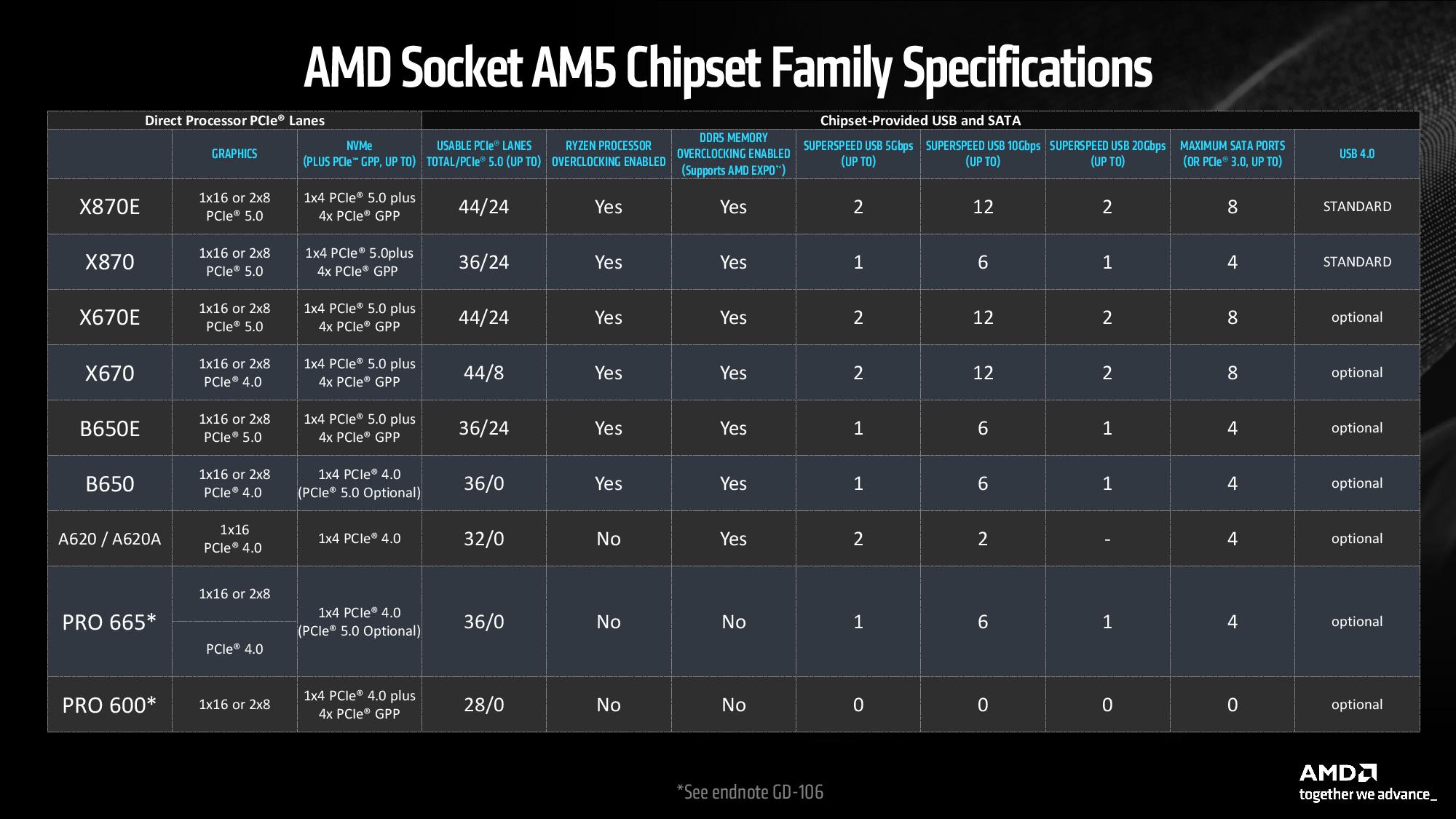AMD boosts Zen 5 official warrantied TDP to 105W, fixes Ryzen 9000 latency issue, launches 800-series chipsets

AMD made a slew of announcements about its latest progress with its Zen 5 Ryzen 9000 processors, with the most important announcement being that the company will now fully support a performance-boosting 105W TDP mode with its Ryzen 5 9600X and Ryzen 7 9700X models. The company also outlined the arrival of game-boosting branch prediction optimizations to the mainline Windows versions, tweaks that improve Ryzen 9000's core-to-core latency, support for DDR5-8000 EXPO memory kits, and the long-awaited arrival of the 800-series chipsets.





AMD has added the improvements to its firmware with AGESA version 1.2.0.2, applicable to any motherboard with an AM5 socket.
AMD's Ryzen 5 9600X and Ryzen 7 9700X came to market with a 65W TDP, a 40% reduction in the TDP rating compared to the prior-gen models. AMD's marketing materials touted this as providing a new level of power efficiency for the desktop PC, but some users questioned AMD's decision to leave extra performance off the table, especially given Zen 5's generally trailing position in gaming benchmarks against Intel's competing Raptor Lake Refresh chips.
AMD's motherboard partners have already added a new 105W TDP option that boosts performance by ~10% in heavily threaded workloads, but do note that this has little impact on gaming performance. AMD has now made this 105W setting official, so it is now covered under the chip warranty and, therefore, falls into the chips' specifications as a cTDP (configurable TDP) option. AMD says the chips were designed to work at this power threshold, so if your cooling can handle it, you can now run the 105W TDP mode with full confidence that the chip will be covered by warranty.
AMD has also addressed high core-to-core latency compared to older chips. This condition occurs when sharing data between cores located on two different chiplets, so it only impacted the Zen 5 Ryzen 9 models. AMD notes the condition "was mainly due to some corner cases where it takes two transactions to both read, and write, when information is shared across cores on different parts of a Ryzen 9 9000 processor," but the new BIOS update cuts the number of transactions in half.
AMD has now corrected the issue but notes it only impacts performance in one scenario - heavily threaded games that don't trigger core parking (a mechanism AMD uses to defray the impact of core-to-core latency in multi-chiplet processors). AMD says Metro, Starfield, and Borderlands 3 benefit, along with 3DMark Timespy.
The company didn't provide specific levels of expected uplift in these few titles, but you should keep your expectations in check. This AGESA update has already been available for some time, and while enthusiasts have recorded latency improvements — an enthusiast measured a 58% reduction in latency (180ns to 75ns) a few weeks ago — there haven't been any reports of significant performance gains in gaming. We have two of those titles in our benchmark regimen, so we'll investigate the improvements when we retest for upcoming reviews.
Get Tom's Hardware's best news and in-depth reviews, straight to your inbox.
AMD also notes that the performance-boosting branch prediction optimizations that were previously only available as an optional Windows Update package are now baked right into the main Windows branches, which was expected. We put the optimizations to the test, but gaming performance improvements vary based on the title. We measured anywhere from a 2.3% to a 4.4% improvement in gaming performance (it varies by chip model) across 19 gaming benchmarks, which doesn't make a meaningful change to the competitive positioning of the Ryzen 9000 chips. But free performance improvements are always good.
AMD also announced support for DDR5-8000 EXPO memory kits with its new AGESA version. The sweet spot for Ryzen 9000 still remains at DDR5-6000, but overclockers and hardcore memory tuning enthusiasts could benefit from the extra 1 to 2ns of latency reduction with the faster memory (as compared to DDR5-6000).




Finally, AMD's long-awaited motherboards with the X870 and X870E chipsets have finally come to market. These boards are a known quantity — AMD gave us the details on them months ago — but now you can finally purchase them.
The upper-tier X870 and X870E chipsets come with modest improvements that stem from new mandatory feature requirements instead of expanded chip connectivity. For instance, the PCIe 5.0 interface is now standard on the X870 lineup for both storage and graphics, whereas it was previously limited to the E-series boards only. All of the X870 boards will now also have the USB 4.0 60 Gbps interfaces courtesy of third-party controllers, like the ASMedia ASM4242 (the controller will consume some of the PCIe lanes from the CPU to operate at full bandwidth). The 800-series is built around the same Promontory 21 chipset silicon from ASMedia as the 600-series and is fully compatible with any Socket AM5 processor. You can see the full spec breakdown and chipset diagrams in the above album.
The X870 and X870E boards are on shelves now, so you'll find plenty of reviews for the new motherboards today, including our own review of the MSI X870E Carbon WIFI.

Paul Alcorn is the Editor-in-Chief for Tom's Hardware US. He also writes news and reviews on CPUs, storage, and enterprise hardware.
-
jeremyj_83 While this will improve performance for applications that can utilize all cores, this will not help gaming performance if that is important to you. For gaming both the 7700X and 9700X were drawing the same PPT (70W vs 71W) while gaming. That means that the 105W TDP won't help at all as they CPU is still within the 88W PPT currently.Reply -
Elusive Ruse @PaulAlcorn Thanks for the article, are you planning to benchmark Zen4 and Zen5 CPUs to gauge how much performance has been gained through the Windows 24H2 patch?Reply -
thestryker While the 105W profile isn't universally necessary I certainly appreciate AMD adding it and covering it under warranty. Technically speaking PBO violates the warranty so it's never great to be in a gray area should you end up having problems under warranty.Reply
There's a link in this article to a piece they did testing the KB which was released for 23H2 which adds those optimizations: https://www.tomshardware.com/pc-components/cpus/the-zen-5-gaming-postmortem-larger-generational-gains-than-many-reported-game-boosting-windows-update-tested-ryzen-5-7600x3d-gaming-benchmarks-too#section-amd-performance-gains-from-windows-23h2-updateElusive Ruse said:@PaulAlcorn Thanks for the article, are you planning to benchmark Zen4 and Zen5 CPUs to gauge how much performance has been gained through the Windows 24H2 patch? -
systemBuilder_49 I can imagine AMD wanting to restrict its new 4nm chips to 65w after Intel has performed a perfect "10" of a faceplant with its ringbus burnout issues on 13900 and 14900 CPUs. Now as the leader in Desktop CPUs, a lot of responsibilities are falling to AMD, such as revealing and identifying Microsoft's blunders and mistakes in their operating system, which wreck performance. It's lonely at the top!Reply
What I'm shocked about is that the CPU designers have heavily upgraded the Ryzen 9000 CPUs but there is no thought to improving the ram drivers or switching fabric to make the whole system go faster ... seems like a major oversight by the overall system architect, 3000 Mhz and 2:1 infinity fabric speeds wtf? Same as 7000 wtf? They completely fumbled a chance to improve the 9000 CPUs by at least supporting up to 3600 Mhz and 2:1 or something! -
thestryker Reply
The 9000 series uses the same IO die as the 7000 series so that was never going to change.systemBuilder_49 said:What I'm shocked about is that the CPU designers have heavily upgraded the Ryzen 9000 CPUs but there is no thought to improving the ram drivers or switching fabric to make the whole system go faster ... seems like a major oversight by the overall system architect, 3000 Mhz and 2:1 infinity fabric speeds wtf? Same as 7000 wtf? They completely fumbled a chance to improve the 9000 CPUs by at least supporting up to 3600 Mhz and 2:1 or something! -
jeremyj_83 Reply
I'm running 6400MHz RAM without IF offset.systemBuilder_49 said:What I'm shocked about is that the CPU designers have heavily upgraded the Ryzen 9000 CPUs but there is no thought to improving the ram drivers or switching fabric to make the whole system go faster ... seems like a major oversight by the overall system architect, 3000 Mhz and 2:1 infinity fabric speeds wtf? Same as 7000 wtf? They completely fumbled a chance to improve the 9000 CPUs by at least supporting up to 3600 Mhz and 2:1 or something! -
jeremyj_83 Reply
There is nothing wrong with the 9600X and 9700X in 65W TDP mode. They offer similar or better performance than the previous generation that required 105W TDP. Now you have the choice to go with a 105W TDP. If you need it you have that choice to make to gain extra performance WITHOUT voiding your warranty. If you don't need it then you can keep the advantages of the 65W TDP.Taslios said:this is a long article to say "AMD corrects flaws in rushed release." -
Mama Changa Reply
Well it was widely known Zen 5 was same old F and IO die. Zen 6 is basically about fixing all that is wrong with dual ccd's, moves to 3nm IO die, hopefully much faster IF. No use releasing more cores when even 7950X is bandwidth starved. AMD needs to get 7200MT/s memory as sweet spot and support 10000MT/s+ in 2026.systemBuilder_49 said:I can imagine AMD wanting to restrict its new 4nm chips to 65w after Intel has performed a perfect "10" of a faceplant with its ringbus burnout issues on 13900 and 14900 CPUs. Now as the leader in Desktop CPUs, a lot of responsibilities are falling to AMD, such as revealing and identifying Microsoft's blunders and mistakes in their operating system, which wreck performance. It's lonely at the top!
What I'm shocked about is that the CPU designers have heavily upgraded the Ryzen 9000 CPUs but there is no thought to improving the ram drivers or switching fabric to make the whole system go faster ... seems like a major oversight by the overall system architect, 3000 Mhz and 2:1 infinity fabric speeds wtf? Same as 7000 wtf? They completely fumbled a chance to improve the 9000 CPUs by at least supporting up to 3600 Mhz and 2:1 or something!